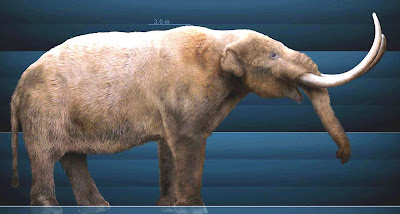Serranía La Lindosa pictographs, online image, Public Domain.
In Colombia, the discovery of a huge concentration of rock art has been announced.
“A research team published the description of tens of thousands of ice age paintings, many apparently depicting extinct megafauna, discovered in a remote region of the Amazon forest. The paintings cover almost 8 miles (12 km) of a cliff face making it one of the largest rock-art sites on the planet. The site of the discovery, the Serranía La Lindosa, sits deep in the rebels-controlled Columbian rainforest. The discovery by a British-Colombian team of archaeologists was made last year - - ."
Serranía La Lindosa pictographs, online image, Public Domain.
According to a preliminary survey,"there are several tens of thousands of images covering the rocks smoothed by fluvial erosion. The images include animals like fish, turtles, lizards and birds, as well as people dancing and holding hands, among other scenes and abstract symbols.” (Bressan 2020)
The team that carried out the research was bi-national and consisted of Jose Iriarte and Mark Robinson from the University of Exeter, Gaspar Morcote-Rios and Jeison L. Chaparro-Cardenas from the Universidad Nacional de Columbia, and Francisco Javier Aceituno from the Universidad de Antioquia. (University of Exeter) The team worked in a region that had been closed until recently because of fighting between Colombia governmental troops and FARC guerillas.
“This is one of the largest collections of rock art found in South America. The recorded drawings, likely first made around 12,600 and 11,800 years ago, are on three rock shelters on hills in the Colombian Amazon. The paintings, identified during landscape surveys, also depict geometric shapes, human figures, and handprints, as well as hunting scenes and people interacting with plants, trees, and savannah animals. The vibrant red pictures were produced over a period of hundreds, or possibly thousands, of years. Some are so high, and inaccessible, special ladders crafted from forest resources would have been needed and they would have been obscured from view for anyone visiting the rock shelter.” (University of Exeter 2020)
The images include geometric shapes, anthropomorphs, and zoomorphs, among others, but what most interests me here are the pictures of animals that appear to illustrate extinct megafauna from the Paleolithic period.
“There are drawings of deer, tapirs, alligators, bats, monkeys, turtles, serpents, and porcupines, as well as what appears to be Ice Age megafauna. These now extinct animals are depicted in rock art in Central Brazil, but experts believe these drawings are more realistic. There are depictions of creatures resembling a giant sloth, mastodon, camelids, horses, and tree-toed ungulates with trunks. These native animals all became extinct, probably because of a combination of climate change, the loss of their habitat and by hunting by humans.” (University of Exeter 2020)
Hippidion reconstruction, online image, Public Domain.
By all accounts a spectacular find, and a rock art site of major importance. The problems, however, begin when we look at the supposed images of the Ice Age megafauna supposedly depicted. "Potential ice-age megafauna species displayed in the pictographs include a giant ground sloth with its young, a mastodon, a prehistoric relative of the elephant, an early horse (Hippidion?) walking alongside an unidentified camelid, maybe of the genus Paleolama, and a long necked, three toes ungulate with a trunk, maybe Zenorhinotherium or Macrauchenia." (Bressan 2020)
Paleolamareconstruction, online image, Public Domain.
“We started seeing animals that are now extinct. The pictures are so natural and so well made that we have few doubts that you’re looking at a horse, for example. The ice-age horse had a wild, heavy face. It’s so detailed, we can even see the horse hair. It’s fascinating.” (Alberge 2020)
The sloth is actually fairly convincing as well as the extinct horse. The pictographs look very much like the actual creatures. The other animals identified may or may not actually be accurate. The "mammoth," the "Paleolama" and the "Zenorhinotherium or Macrauchenia" strike me as much more of a guess than a distinct identification.
Macrauchenia reconstructions (hairy and shorthaired), online image, Public Domain.
It is always exciting to find a record that illustrates extinct animals, and this discovery, because of its large scale, provides a wealth of new possibilities for research. While some of the illustrations of extinct creatures are easy to identify, others take a little more imagination. All in all though, this is a world class, major discovery.
NOTE: Some images in this posting were retrieved from the internet with a search for public domain photographs. If any of these images are not intended to be public domain, I apologize, and will happily provide the picture credits if the owner will contact me with them. For further information on these reports you should read the original reports at the sites listed below.
REFERENCES:
Alberge, Dalya, 2020, “Sistine Chapel of the Ancients” rock art discovered in remote Amazon Forest, 29 November 2020, The Guardian.
Bressan, David, 2020, A Treasure Trove of Rock Art Depicting Extinct South American Megafauna Discovered in Amazon Forest, https://www.forbes.com
University of Exeter, 2020, Newly Discovered Amazon Rock Art Shows the Rainforest’s Earliest Inhabitants Living With Giant Ice Age Animals, December 1, 2020, https://phys.org/news/2020-12-newly-amazon-art-rainforest-earliest.html

















No comments:
Post a Comment